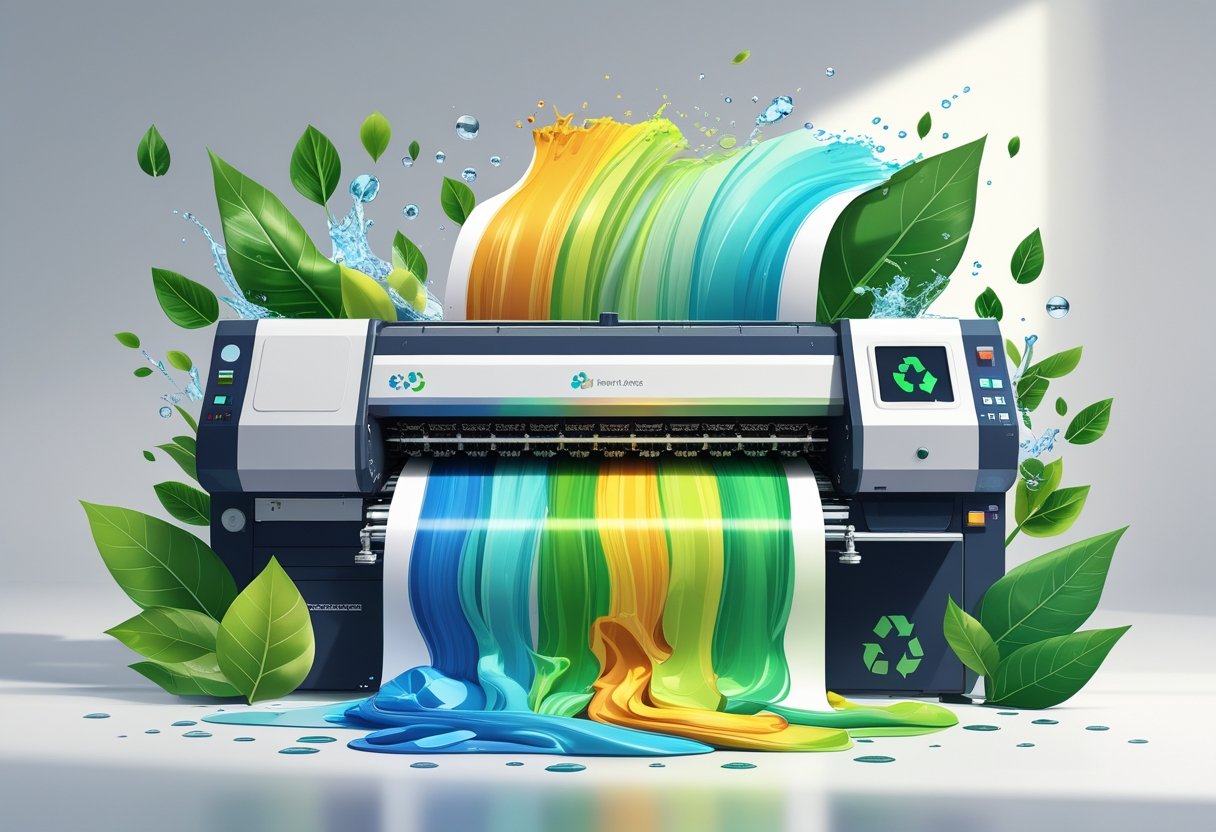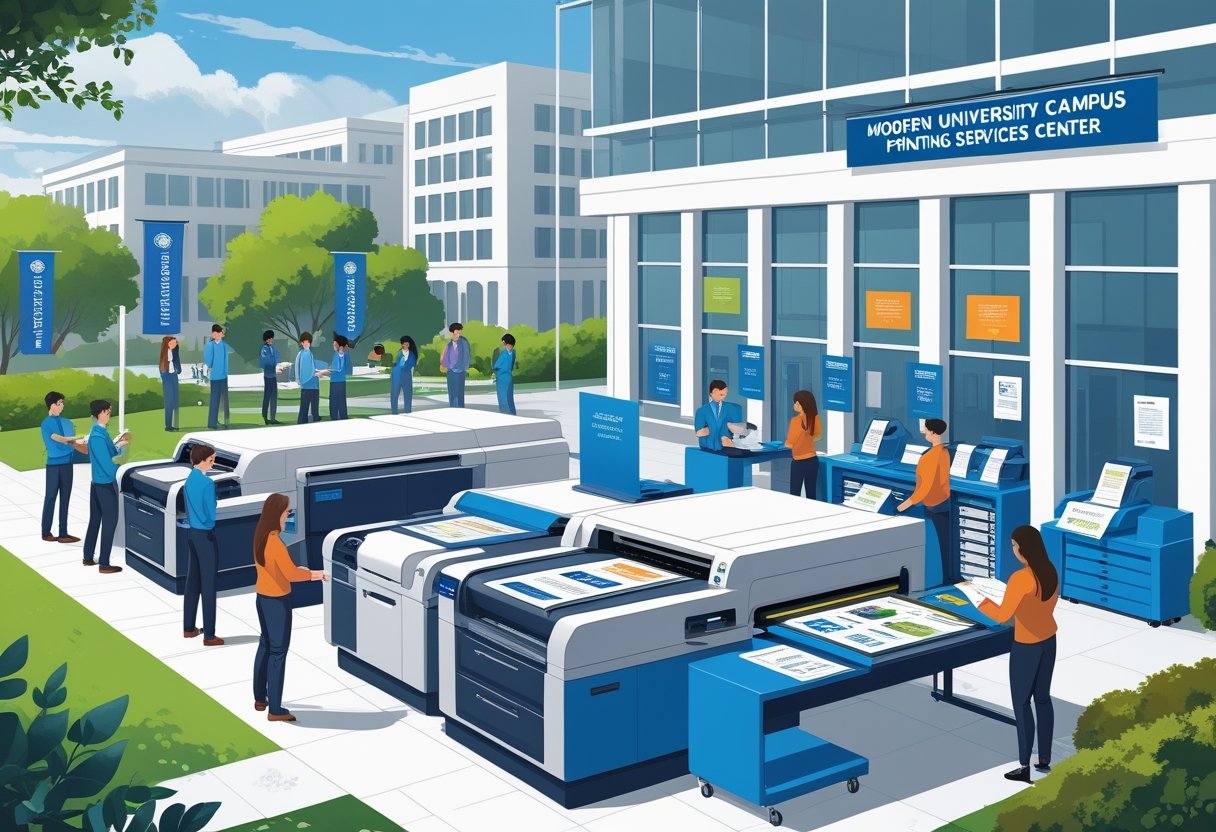As sustainability becomes increasingly vital in the printing industry, you may be exploring options that align with eco-friendly practices. Eco-friendly inks for commercial printing offer an effective solution, enabling you to reduce your environmental impact without compromising on quality. These inks, which can include water-based, soy-based, and algae-based options, provide vibrant colors and high performance while contributing to a healthier planet.
When you choose environmentally friendly inks, you not only support green manufacturing processes but also enhance your brand's image in the eyes of environmentally conscious consumers. Companies like Mail Processing Associates understand the importance of sustainable solutions. We specialize in Comprehensive Mailing and Printing Solutions that cater specifically to businesses looking to optimize their processes while embracing eco-friendly practices.
Transitioning to eco-friendly inks is a proactive step toward sustainability in your commercial printing efforts. By partnering with Mail Processing Associates, you gain access to top-tier services designed to meet your unique needs, helping you strike the perfect balance between quality and environmental responsibility.
Core Principles of Eco-Friendly Inks
Eco-friendly inks play a crucial role in reducing the environmental impact of commercial printing. Understanding the core principles surrounding sustainability, VOC content, and biodegradability will help you make informed choices about printing materials.
Sustainability in the Printing Industry
Sustainability in the printing industry emphasizes both environmental protection and resource efficiency. Eco-friendly inks are typically made from renewable resources, which reduces dependence on petroleum-based products.
Key attributes of sustainable inks include:
- Plant-based formulations: These inks use ingredients derived from natural sources, such as soy and algae, that are less harmful to the environment.
- Reduced carbon footprint: Sustainable inks contribute to lowering greenhouse gas emissions in the printing process.
- Recyclability: Many eco-friendly inks enhance the recyclability of printed materials, aligning with circular economy principles.
Mail Processing Associates is committed to providing eco-friendly printing solutions that meet these sustainability goals.
Volatile Organic Compounds and VOC Content
Volatile Organic Compounds (VOCs) are chemicals that can evaporate into the air and contribute to air pollution. Reducing VOC emissions in the printing process is essential for a healthier work environment and planet.
Consider the following aspects:
- VOC levels: Eco-friendly inks often feature lower VOC levels compared to traditional inks, minimizing their harmful impact.
- VOC emissions: By using inks with reduced VOC emissions, you can improve indoor air quality and comply with environmental regulations.
- Health benefits: Lower VOC content also translates to fewer health risks for workers and consumers exposed to printed materials.
Adopting eco-friendly inks can help your business align with industry regulations and improve workplace safety.
Biodegradability and End-of-Life Considerations
The end-of-life impact of inks is a significant factor in sustainable printing. Biodegradable inks break down more efficiently, minimizing environmental harm.
Important considerations include:
- Biodegradability: Eco-friendly inks are specifically formulated to decompose naturally over time, reducing landfill waste.
- Environmental impact: Using biodegradable inks can help mitigate pollution and protect ecosystems.
- Recycling compatibility: Many eco-friendly inks are designed to work well with recycling processes, ensuring that printed materials can be efficiently recycled without contamination.
By selecting biodegradable options, you're contributing to a more sustainable future in printing. For businesses aiming for responsible mailing and printing processes, Mail Processing Associates offers tailored solutions that prioritize eco-friendly practices.
Major Types of Eco-Friendly Inks
When exploring eco-friendly inks for commercial printing, you will find a variety of options that cater to different needs and applications. Understanding these types will help you make informed decisions for sustainable printing processes.
Water-Based Inks and Their Applications
Water-based inks use water as a primary solvent, making them less harmful to the environment compared to traditional solvent-based inks. These inks are primarily composed of pigments or dyes suspended in a water solution.
Key applications:
- Packaging: Widely used in flexible packaging due to their excellent adhesion.
- Textiles: Safe for fabric and eco-friendly, they facilitate vibrant prints.
- Paper Products: Ideal for printing on paper materials, ensuring a low-VOC footprint.
Water-based inks are known for their fast drying time and ease of cleanup, allowing for improved operational efficiency. They also exhibit lower toxicity, making them a favorable choice for businesses focused on sustainability.
Soy-Based and Vegetable-Based Ink Alternatives
Soy-based inks utilize soybean oil as the primary fluid, promoting sustainability by relying on a renewable resource. These inks often outperform traditional petroleum-based options in color vibrancy and print quality.
Benefits of soy-based and vegetable-based inks include:
- Biodegradability: They decompose more easily, reducing long-term waste.
- Low VOC Emissions: Minimized air pollution during printing makes them healthier for indoor use.
- Versatility: Suitable for various applications, including commercial and fine printing.
Switching to soy or vegetable-based options can significantly enhance your brand's eco-friendly image while maintaining high-quality outputs. Mail Processing Associates provides tailored options ideal for businesses looking to adopt sustainable practices.
UV-Curable Ink Technologies
UV-curable inks are unique because they use ultraviolet light to dry or cure the ink immediately upon application. This technology allows for faster printing speeds and less waste.
Advantages include:
- Durability: Once cured, these inks offer excellent resistance to scratching, fading, and chemicals.
- Energy Efficiency: Reduced energy consumption during the curing process compared to traditional methods.
- Environmental Considerations: Lower VOC emissions since these inks are solvent-free.
UV inks allow printers to produce high-quality prints on various substrates, including plastics, metal, and glass, offering exceptional versatility.
Algae-Based Ink Innovations
Algae-based inks represent a new frontier in sustainable printing technologies. These inks are derived from algae, known for their rapid growth and minimal environmental impact.
Prominent features include:
- Sustainability: Algae is a renewable resource that requires less land and water compared to traditional crops.
- Biodegradability: They break down more easily than conventional inks, cutting down on long-lasting waste.
- Environmental Benefits: Algae can absorb CO2 during growth, further contributing to eco-friendliness.
Incorporating algae-based inks can help position your brand as a leader in sustainability initiatives. If you want comprehensive mailing and printing solutions, consider the services of Mail Processing Associates to optimize your operations effectively.
Eco-Friendly Inks for Different Printing Methods
Understanding the types of eco-friendly inks available for various printing methods can help you make informed decisions tailored to your needs. Each printing process has specific requirements that can affect your choice of ink, sustainability, and print quality.
Offset Printing and Sustainable Ink Choices
Offset printing traditionally employs petroleum-based inks, but sustainable options are now available. Soy-based inks and vegetable oils significantly reduce VOC emissions and environmental impact. These inks offer vibrant colors and high-quality prints, which makes them suitable for a range of applications.
Many manufacturers now offer eco-friendly ink formulations that meet the same durability standards as traditional inks. They provide excellent adhesion to various substrates while being better for the environment. If you're using offset printing, consider investing in sustainable ink to align with your business's eco-conscious initiatives.
Digital Printing and Water-Based Alternatives
Digital printing has evolved rapidly, and so have the ink technologies associated with it. Water-based inks are a popular choice for digital printing due to their low environmental impact. Unlike solvent-based inks, water-based options emit fewer harmful fumes and are easier to dispose of.
These inks are designed to work well with inkjet printers while providing high-quality color reproduction. They are also versatile for various surfaces, making them ideal for commercial printing. When you need digital printing that is both effective and sustainable, water-based inks should be your go-to option.
Large Format and Latex Ink Solutions
Large format printing requires inks that can withstand various environmental conditions. Latex inks have emerged as an eco-friendly alternative that provides flexibility and durability. Made from water-based formulations, these inks emit minimal VOCs and have a lower environmental footprint.
Latex inks also offer excellent adhesion and outdoor longevity, making them suitable for banners, signage, and other large print materials. They dry quickly and can be printed on a wide range of substrates, from vinyl to paper. Choosing latex inks can enhance your large format printing while supporting sustainable practices.
For businesses looking to streamline their mailing and printing processes, Mail Processing Associates offers comprehensive solutions that combine sustainability with high-quality outcomes. Equip your operations with eco-friendly inks to make a positive environmental impact without compromising on print performance.
Environmental and Health Impacts
Eco-friendly inks are designed to minimize their environmental footprint while ensuring safety for users and consumers. These inks reduce harmful emissions and improve overall printing processes. Here’s a closer look at their environmental and health impacts.
Reducing Carbon Footprint and Emissions
Using eco-friendly inks plays a significant role in lowering your carbon footprint. These inks often utilize renewable resources and non-toxic materials, leading to reduced greenhouse gas emissions during production and application.
By switching to eco-friendly inks, you can help decrease the overall VOC emissions that contribute to air pollution. Reducing VOCs not only benefits the environment but also enhances indoor air quality, making workspaces safer for your employees.
Choosing eco-friendly packaging materials alongside these inks further amplifies your sustainable practices. This holistic approach can lead to meaningful reductions in resource usage and waste generation.
Comparison to Solvent-Based Inks
Solvent-based inks are traditionally used in commercial printing but often contain harmful solvents that release high levels of VOCs. In contrast, eco-friendly inks produce significantly lower emissions, making them a healthier choice for both the environment and your workforce.
Key Differences include:
- Emissions: Eco-friendly inks emit less than 50% of the VOCs found in solvent-based inks.
- Materials Used: Solvent-based inks often use petroleum derivatives, while eco-friendly inks may utilize plant-based or water-based formulations.
The health benefits of switching to eco-friendly options cannot be overstated. By choosing inks that minimize harmful content, you protect not just the environment but also the well-being of your workers and consumers.
Safety for Packaging and Food Contact
When it comes to packaging, particularly food contact materials, safety is paramount. Eco-friendly inks meet stringent safety regulations and standards, ensuring that harmful substances do not leach into food products.
Many eco-friendly inks are tested for migration properties, which confirms they do not transfer harmful compounds during storage or transportation. This attribute is especially critical for businesses involved in food and beverage industries.
With providers like Mail Processing Associates, you can access comprehensive mailing and printing solutions that prioritize safety and sustainability. Our eco-friendly inks ensure that your packaging aligns with safety standards while making a positive impact on the environment.
Challenges and Considerations in Commercial Adoption
Adopting eco-friendly inks can lead to a sustainable printing process, but there are significant challenges to consider. Key issues include cost and performance trade-offs, along with the complexities of color management when using sustainable materials. Understanding these aspects will help you make informed decisions.
Cost and Performance Trade-Offs
The transition to eco-friendly inks often presents financial implications. While sustainable options may have a higher upfront cost compared to traditional inks, they can provide long-term savings in operational efficiency and regulatory compliance.
Key considerations include:
- Initial Investment: Sustainable inks generally require more investment, which can affect your budget.
- Performance Metrics: Eco-friendly inks sometimes struggle to match the performance of conventional inks, particularly in areas like drying time and color vibrancy.
- Regulatory Compliance: Investment in eco-friendly materials may help businesses avoid future regulatory costs associated with traditional ink disposal and use.
Mail Processing Associates offers tailored solutions that align with your budget while ensuring quality efficiency.
Color Management with Sustainable Inks
Effective color management is crucial when adopting eco-friendly inks. The properties of sustainable inks may vary significantly, affecting color output and consistency.
Consider the following aspects:
- Color Matching: Sustainable inks can behave differently, requiring adjustments in printing techniques to achieve consistent colors on different substrates.
- Software Tools: Utilize advanced color management software to calibrate your printers and inks, ensuring accurate color reproduction across jobs.
- Training: Staff may require additional training to effectively manage eco-friendly ink applications, which can involve time and resource investments.
At Mail Processing Associates, our expertise in color management helps optimize your printing processes to meet sustainability standards without compromising quality.
Frequently Asked Questions
In this section, you will find answers to common inquiries regarding eco-friendly inks in commercial printing. These responses address benefits, quality concerns, substrate compatibility, cost implications, regulatory influences, and effective transition strategies.
What are the main benefits of using eco-friendly inks in commercial printing?
Eco-friendly inks offer several advantages, including reduced environmental impact and improved safety for workers and consumers. They are often made from renewable resources, such as vegetable or soy-based materials, which help minimize reliance on petroleum products. Additionally, many eco-friendly inks have a lower volatile organic compound (VOC) content, making them safer for indoor air quality.
How do eco-friendly inks impact the quality of printed materials compared to traditional inks?
The quality of prints achieved with eco-friendly inks can match or even exceed that of traditional inks. Modern formulations allow for vibrant colors and sharp details. If you choose a reputable supplier, such as Mail Processing Associates, you can ensure that the eco-friendly inks used will meet your high standards for quality and durability.
Can eco-friendly inks be used on a wide variety of substrates in commercial printing?
Yes, eco-friendly inks can be formulated for compatibility with various substrates, including paper, cardboard, and certain plastics. It’s essential to verify substrate compatibility when selecting inks to ensure optimal adhesion and appearance. This flexibility allows you to expand your product offerings while maintaining an eco-conscious approach.
What are the cost implications of switching to eco-friendly inks in commercial printing?
While the upfront costs of eco-friendly inks can be slightly higher, the long-term benefits often justify the investment. They may reduce waste disposal costs and increase market appeal to environmentally aware consumers. Many businesses find that the savings in operational costs and improved brand reputation outweigh the initial price difference.
How do regulations and certifications affect the choice of eco-friendly inks in the printing industry?
Regulations vary by region but increasingly favor the use of eco-friendly materials in printing. Certifications such as FSC (Forest Stewardship Council) and Green Seal can guide your decisions when selecting inks. Adhering to these standards not only ensures compliance but also enhances your brand's credibility in the marketplace.
What steps should a commercial printer take to transition to eco-friendly inks effectively?
Begin by assessing your current ink usage and identifying eco-friendly alternatives that suit your operations. Seek advice from suppliers about compatible inks and necessary adjustments to your printing processes. Engaging with a knowledgeable partner like Mail Processing Associates can facilitate a smooth transition, ensuring your business adopts sustainable practices without compromising quality.






.png)






